Hot on the heels of the record payments made under the Feed-in-Tariff scheme in the year to end March 2024, the data is now available for subsidies paid under the Contract for Difference Scheme (CfDs) in calendar year 2024. The data comes from the Low Carbon Contract Company (LCCC). The data is subject to minor revision and the data snapshot for this piece was taken on January 14th, 2025.
A record £2.4 billion was paid out in subsidies across a range of technologies, but the largest recipient was offshore wind. There are some other interesting facts buried in the data that we can now explore.
How Do CfDs Work?
I am often asked how CfDs work, so it is worth giving a brief explanation before diving into the detail of the data. I have pulled Figure 1 below from the Renewable Exchange to illustrate how they work.
The black line shows the market price (or reference price) of electricity on any given day. The red line is the CfD strike price and reflects how much the generator will get paid for its electricity, regardless of the market value. Note that in reality, as we shall see below, the average strike price for active offshore wind CfDs is over £150/MWh.
When the black line is below the red line, the generator receives the market price for the electricity generated plus a CfD top-up (subsidy) for the difference. On the rare occasions when the market price is above the strike price, the generator pays back money to the LCCC as illustrated by the blue line, so its net revenue is equal to the strike price.
Full Year Subsidies
Figure 2 shows the full year subsidies since the scheme began in late 2016, broken down by technology type.
As well as 2024 being a record year overall, offshore wind received more subsidy than in any other year with £1.9 billion paid out. Biomass conversion, a euphemism for burning trees, received £309 million and biomass with combined heat and power (CHP) received a further £90 million. Onshore wind received £73 million and the two solar farms with active CfDs received just over £1 million.
Incidentally, in December 2024, £260.3 million was paid out in subsidies, the second highest month on record, with April 2024 being the highest at £269.8 million.
Supporters of renewables often point out that when the market price of electricity is above the CfD strike price, then generators pay money back. This is true, but that was only significant in 2022 when a net £346 million was repaid and compares to the net cost of the scheme of £9.6 billion since inception.
Top-20 Subsidy Days
From the data, it is also possible to work out the Top-20 subsidy days since the scheme began. These are listed in Figure 3 below.
The top thirteen CfD subsidy days all occurred in 2024, and a total of 16 days from the same year all appear in the Top-20. The day with the highest subsidy payments was December 22nd, 2024, with over £20 million paid out in a single day. Offshore wind was the main recipient of this Government mandated largesse on that day, getting over £18.3 million and biomass receiving over £1 million.
The record subsidy days in December last year came despite elevated gas prices pushing up the reference price. The annual indexation of CfD strike prices with inflation means that as each year progresses, we are likely to see many more record subsidy days, especially if gas-prices fall back to more normal levels.
Top CfD Subsidy Recipients
We can also see the top recipients of the subsidy largesse. The all-time Top-10 list is shown in Figure 4a below with the Top-10 for 2024 shown in Figure 4b.
Six of the all-time Top-10 recipients are offshore wind farms. Walney has received the most at £1.76 billion, with Hornsea Project 1 coming in second at £1.67 billion. In third place is Drax that has been paid £1.6 billion in subsidy for burning trees. Note Drax also has another plant that is funded by Renewables Obligation Certificates, so this is only part of the story. The other offshore wind farms in the Top-10 are Dudgeon, Beatrice, Burbo Bank and East Anglia One. Lynemouth and Teesside Biomass plants also make the Top-10 along with the Dorenell onshore windfarm.
The 2024 Top-10 is dominated by offshore windfarms, with Drax coming in at number six with Lynemouth biomass plant in ninth place with Teesside Biomass and CHP plant in tenth place.
CfD Electricity Generation
We can now work to explain why the subsidy payments have been rising. To begin with, we can look at total generation as shown in Figure 5.
Generation is also hit an all-time high in 2024, with a substantial increase to offshore wind generation to another annual high due to the activation of the CfDs for Hornsea Project 2 and Moray East in March last year. Biomass and Biomass with CHP also saw considerable increase in output. There are only two active CfDs for solar power and their output is virtually undetectable.
CfD Strike Prices
As can be seen in Figure 6, in general strike prices rise over time as they get indexed up with inflation in April each year.
The strike price for Biomass has gone up each year since 2017 rising from £107/MWh to over £139/MWh last year. A similar picture emerges for onshore wind and solar. The exception is offshore wind where prices fluctuated in the £160-165/MWh range from 2017 to 2022. Then there was a big jump in 2023 to £171/MWh before falling back to £154/MWh in 2024. The drop in 2024 can be explained by Hornsea Project 2 and Moray East activating their CfDs in March 2024. The strike price for these two projects is much lower than the other projects at £78/MWh, so they brought down the average even though the strike price of the other projects indexed upwards.
CfD Reference Prices
The weighted average reference price for the year (equivalent to the black line in Figure 1) has fluctuated a lot since 2017 as shown in Figure 7.
The charts for offshore wind, onshore and solar are all very close, so for clarity this chart shows just the intermittent reference price for offshore wind. The various flavours of biomass use a different reference price called the Baseload Market Reference Price (BMRP) and we shall deal with separately. Average offshore wind reference prices were in the range £41-57/MWh from 2017 to 2019. Prices plummeted in 2020 as gas prices and demand fell due to Covid. Prices rose in 2021 to an average of £115/MWh mainly due to the energy crisis that began in the second half of that year. Prices rose again in 2022 to £177/MWh as the energy crisis continued with Russia’s invasion of Ukraine before falling back somewhat to £89/MWh in 2023. Prices have fallen further in 2024 to £67/MWh even though prices have been somewhat elevated in the latter part of the year.
CfD Subsidies Per MWh
The difference between the strike price and the reference price allows us to calculate the subsidies received per MWh of generation as shown in in Figure 8.
In 2022, all technologies paid back into the system on average, with negative subsidies per MWh generated. However, in 2023 and 2024 subsides rose back into positive territory for all three intermittent technologies.
We can see the share of market revenue and subsidy revenue for each technology in 2024 set out in Figure 9.
Offshore wind received subsides of £86/MWh, which is more than the intermittent reference price of £67/MWh, meaning that on average CfD funded offshore wind farms got more of their revenue from subsidies (56%) than they got from selling their power on the market. Onshore wind received £48/MWh (43%) and solar got £45/MWh (41%) of their revenue from subsides.
Load Factors
We can also calculate the average load factor for the main intermittent technologies funded by Contracts for Difference as shown in Figure 10.
We can see a general downtrend in the amount of electricity generated compared to nameplate capacity for all three technologies. However, offshore wind achieved a load factor of just 38.7%, the lowest on record, despite new wind farms coming online. However, the average is skewed somewhat by Moray East that had a load factor of just 21%, probably reflecting a high level of curtailment during the year. Curtailment happens when wind is producing more power than there is demand or the grid can handle, so windfarms are asked to switch off. Although Beatrice and Triton Knoll showed a big increase in load factor in 2024 compared to 2023, East Anglia 1 and Hornsea Project One both saw significant reductions.
CfD Subsidies for Biomass Plants
Moving back to biomass plants, we can see how much subsidy they received per MWh of generation and the relationship between subsidies and generation in Figure 11.
Conclusions
What conclusions can we draw from all this data? It is virtually certain that the overall subsidy payments will continue to rise in the coming years because more offshore wind farms are coming on stream that will push up the level of generation.
It is more difficult to predict strike prices. However, we know that new developments coming online such as Neart na Gaoithe (NNG) where the strike price is currently £158/MWh, coupled with a new round of indexation coming in April will have the effect of pushing up the average strike price. However, other projects with lower strike prices such as Dogger Bank and Sofia may come online and activate their CfDs too which would push strike prices in the opposite direction.
Reference prices are even harder to predict because we do not know future gas-prices which are the main driver of reference prices. Higher gas prices would tend to reduce subsidies because the reference price goes up. Gas prices are currently elevated, so provided global tensions do not escalate, we might expect gas-prices to fall and therefore reference prices would fall too and subsides would rise. Moreover, putting more offshore wind on the grid tends to reduce reference prices when it is most windy. Lower reference prices would tend to increase subsidies per MWh at the time when there is most generation.
It is sad to conclude that we are in for higher bills as the bill for Contracts for Difference continues to escalate.
David Turver writes the Eigen Values Substack, where this article first appeared. He will be giving a Sacred Cows talk on January 28th in London entitled “Net Zero: Why the cure is worse than the climate change disease”. More details and ticket details can be found here.

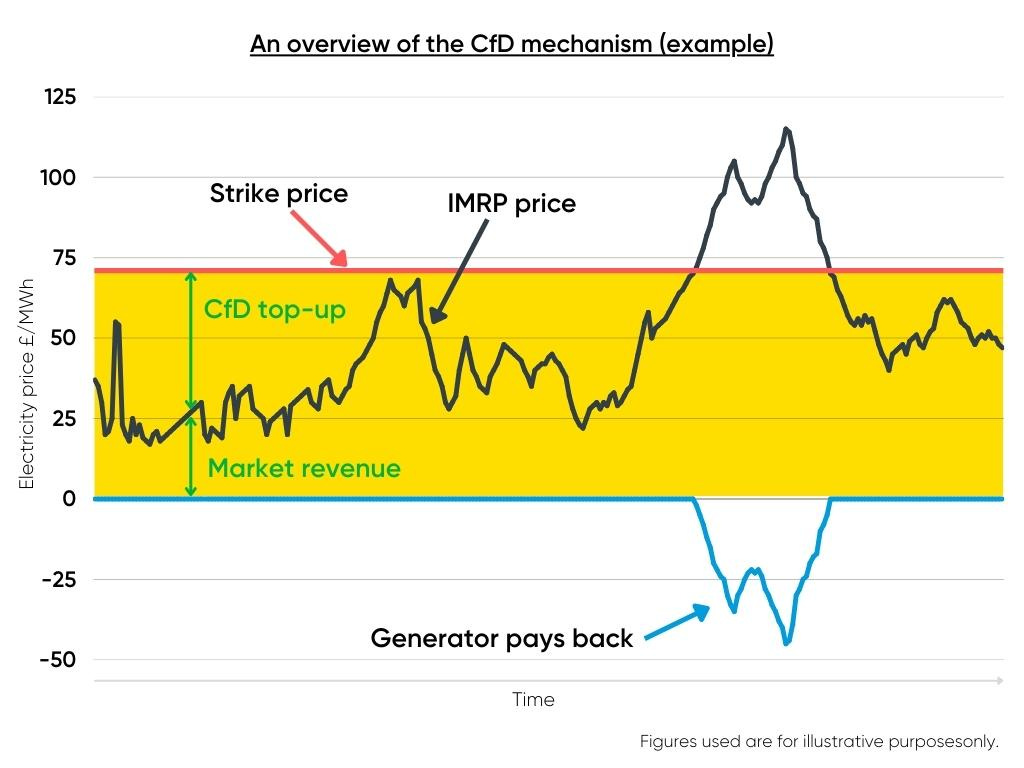
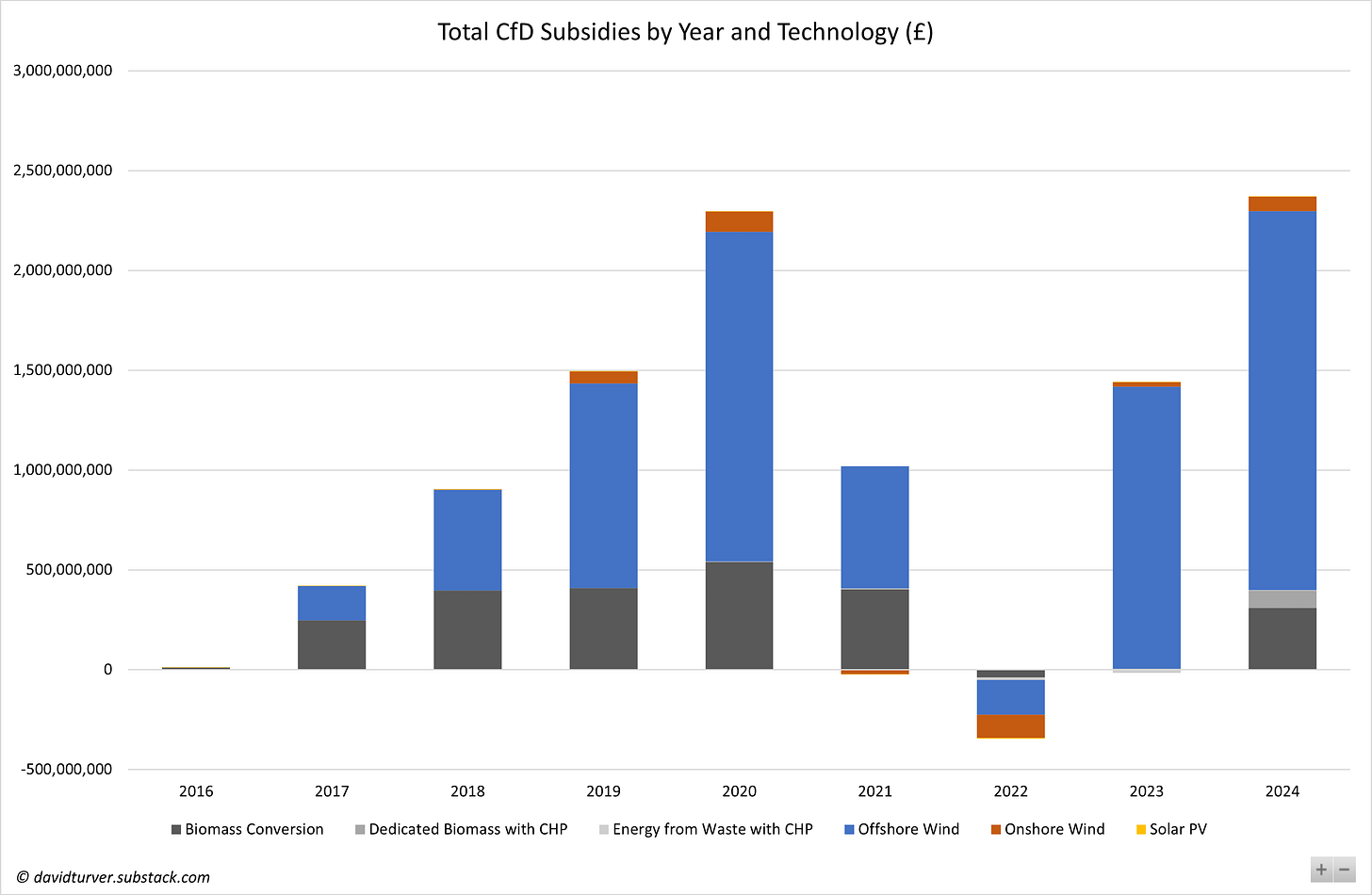
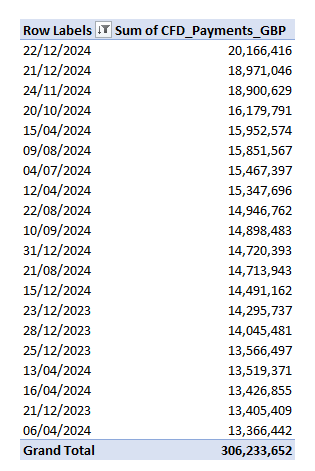
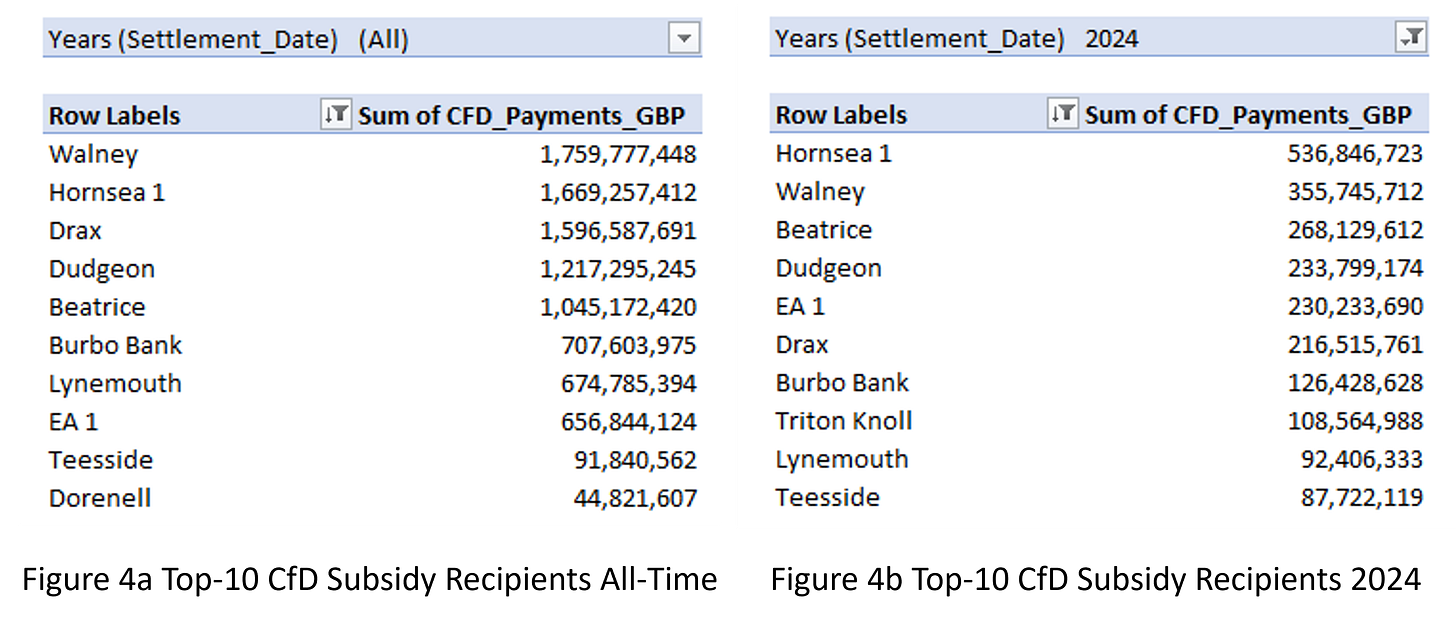

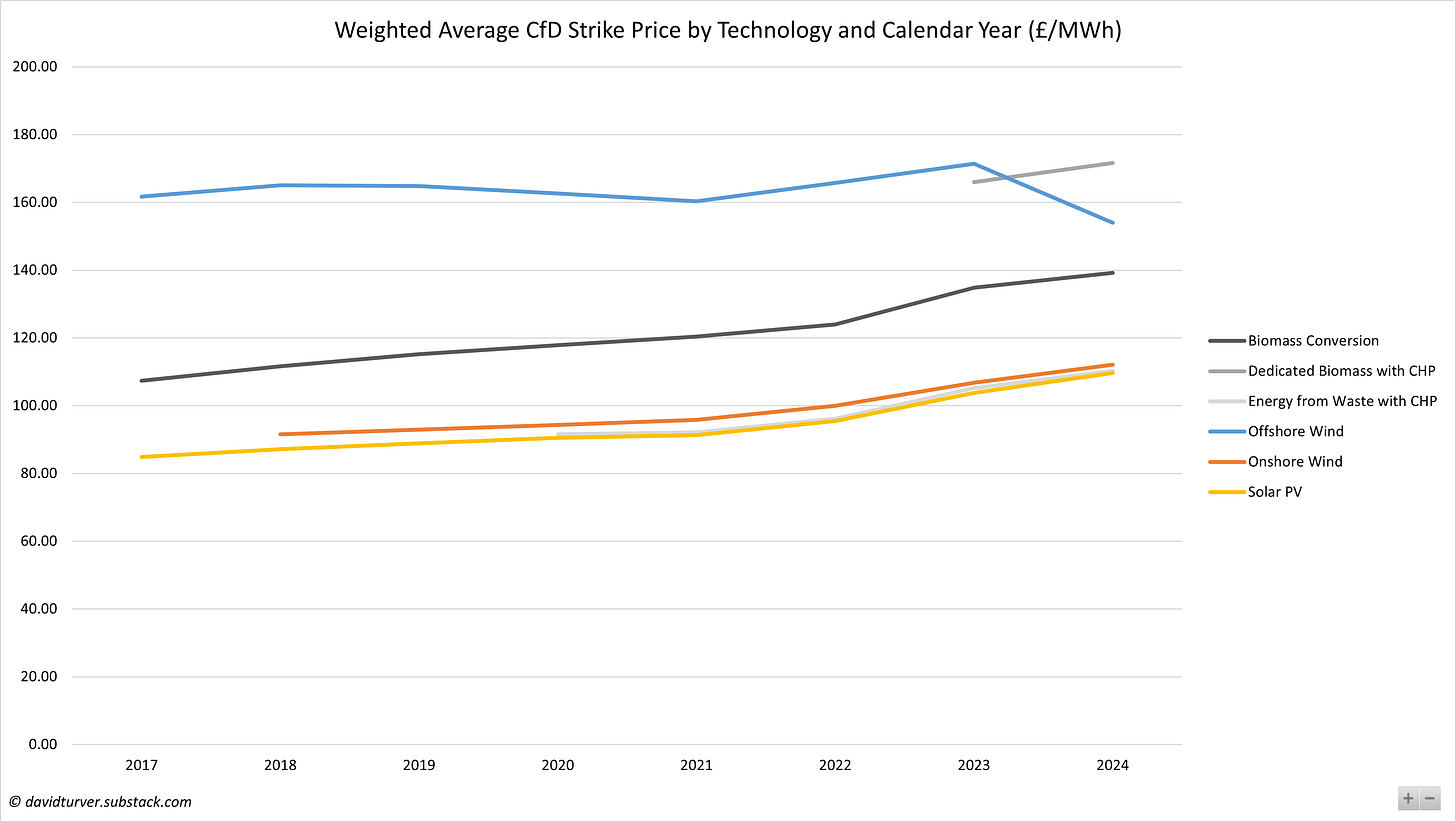
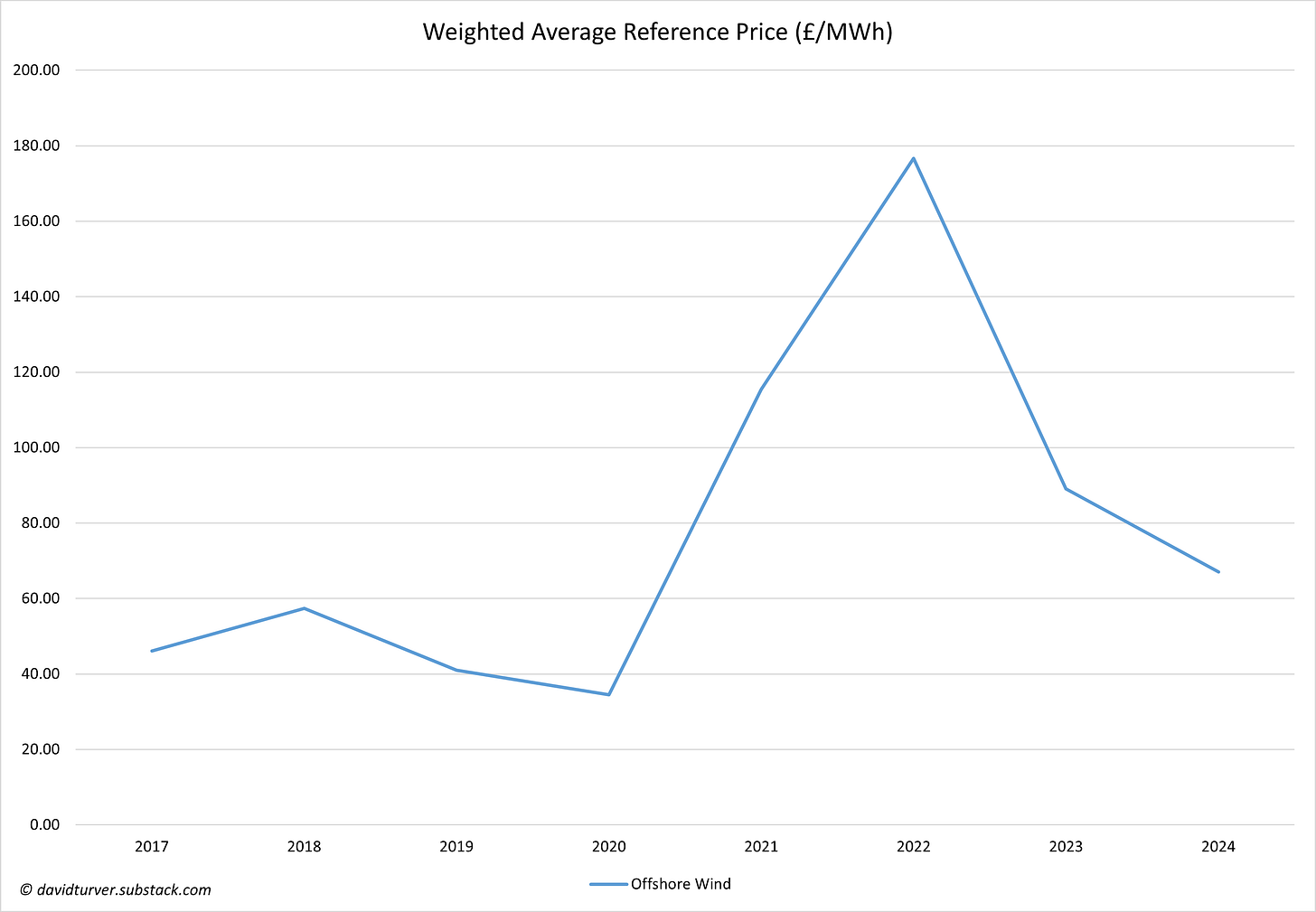
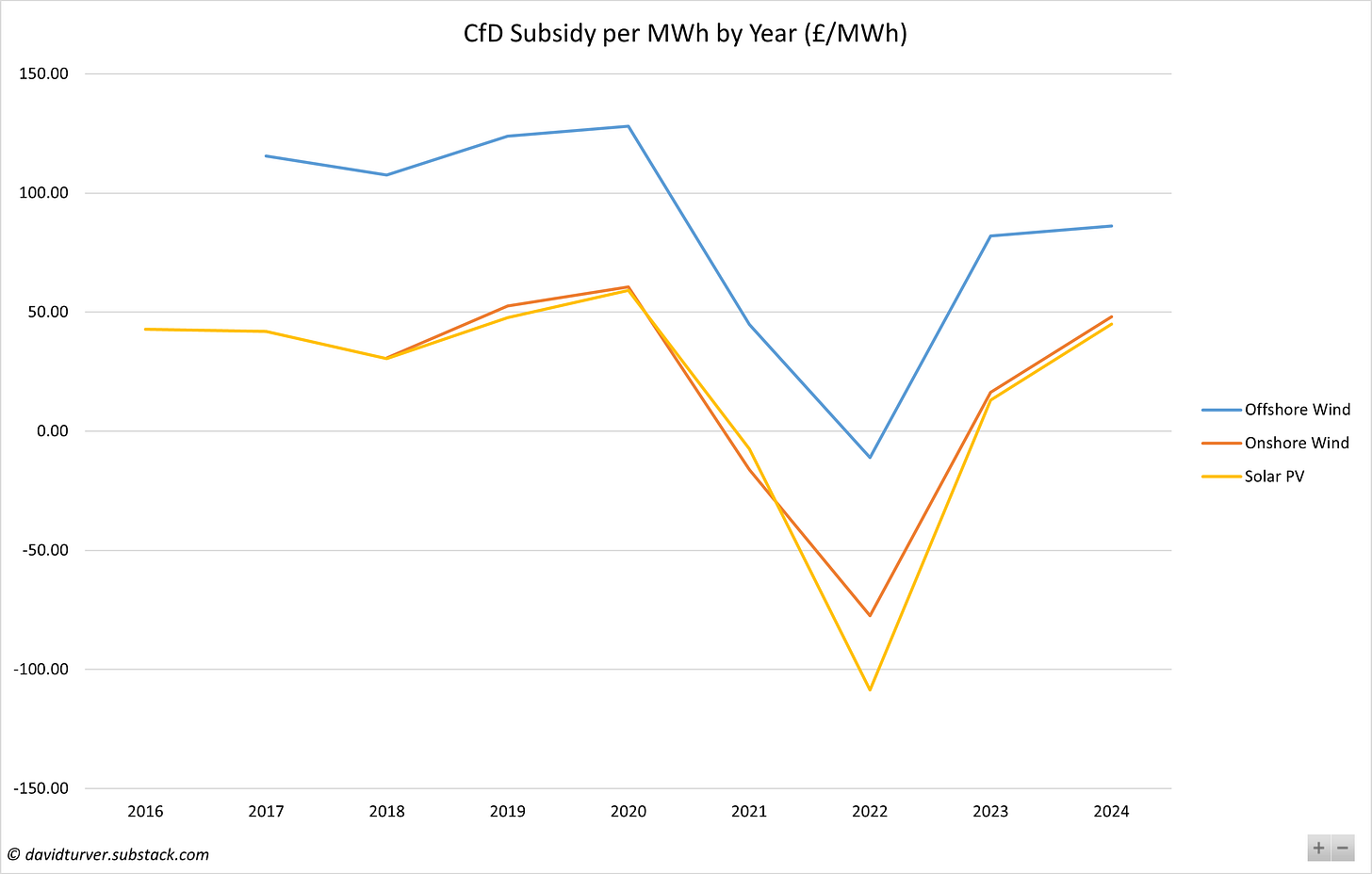
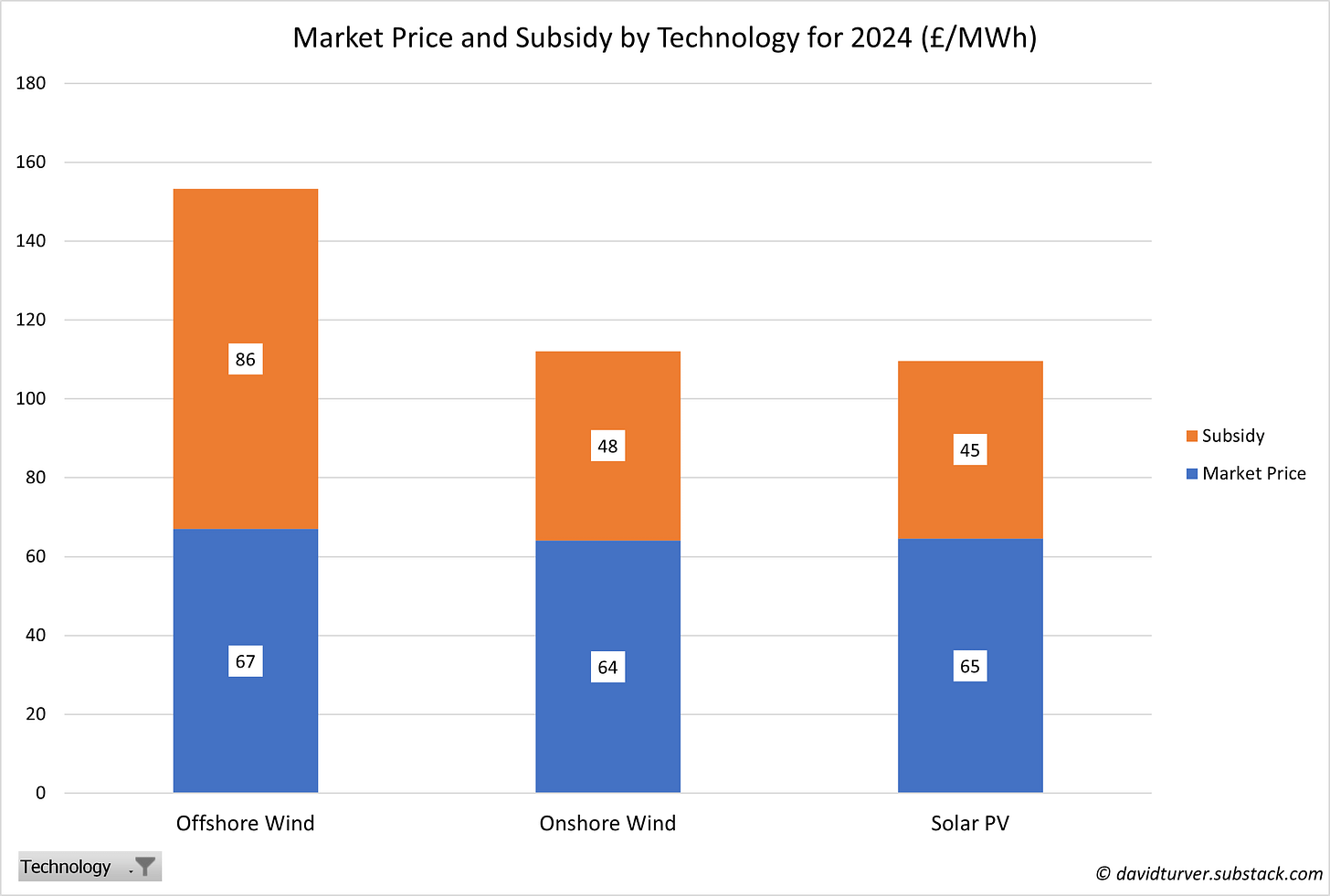
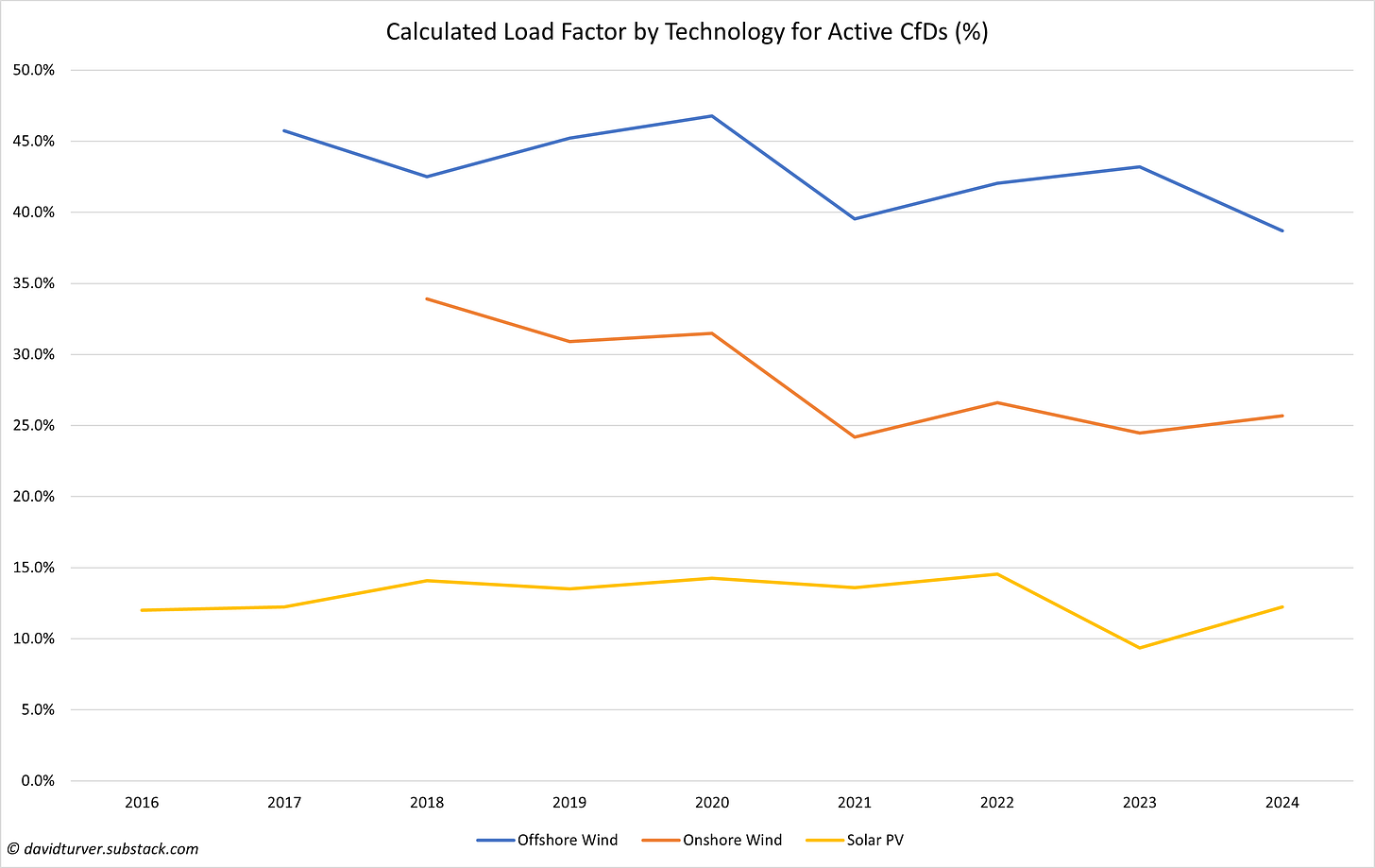













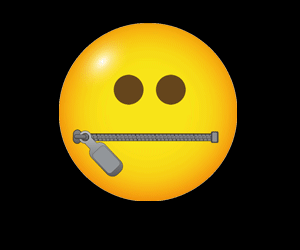
To join in with the discussion please make a donation to The Daily Sceptic.
Profanity and abuse will be removed and may lead to a permanent ban.
It’s also important to keep in mind that this is what Miliband refers to as private investment: So-called private companies building windfarms et al in order to qualify for a revenue guaranteed by the state. These so-called investments carry exactly zero financial risk for the so-called investors. They just need to build windmills to reap guaranteed profits, regardless if there’s any market demand for the so-called product. That’s little more than large-scale robbery of the taxpaying population.
It’s central planning, is what it is.
The government has decided in advance what you will pay for electricity.
The only question is whether you pay it all directly to the electricity company or some of it to the electricity company and some in taxes. Depends on the day.
Blatant money-laundering.
Dale Vince is awarded government contracts and Dale Vince rewards the Labour Party with millions in donations. It couldn’t be more blatant.
It actually isn’t, at least not insofar my understanding for the process goes. These contracts are auctioned off to eligible suppliers. The government decides on a number of auction parameters, the most important being the total budget available for CfDs and the maximum strike price it’s willing to pay. Eligible suppliers than make a sealed bid stating the lowest strike price they’re willing to work with and the capacity they can provide. Bids are then accepted on a cheapest-first basis until either the desired capacity or the budget limit have been reached (simplification).
This means it’s basically the suppliers of energy from so-called renewables who decide how much money they want to earn during the 15-year period the contract runs for and the government accepts this on behalf of the people supposed to pay for it or doesn’t. To make these procedure even more corrupted (from a market perspective), it’s really the government making a bid, namely, the maximum strike price, which suppliers may or may not accept and if they don’t, the government will have to make a higher bid, or, simplified, the maximum strike price the government will offer is really decide by a cartel of renewables operators beforehand.
A famous statement about software design (C.A.R Hoare) is There are two ways to construct a software design. One way is to make it so simple that there are obviously no deficiencies, and the other way is to make it so complicated that there are no obvious deficiencies. The CfD procedure is an example of the latter kind of design. It’s meant to be so complicated that people have difficulties understanding how exactly they’re being ripped off.
Take away the subsidies and the whole sector collapses.
This does not imply there is no utility for some forms of “Renewables”
Just not at scale, and not as primary energy sources.
Solar PV’s on a house rooftop can provide a reasonable amount of electricity, especially in combination with battery storage – but not at large scale.
I’m not so sure about that. The crucial question is Is such an installation net-positive?, does it generate more usable energy during its projected lifetime than was necessary to build it and I don’t think so. If this was otherwise, subsidies wouldn’t be needed as the operation would be commercially viable on its own (instead of just being politically desired).
Basically no one would ever build a turbine if there was no subsidy. They build them to farm the subsidy. ——-NO SUBSIDY=NO WIND FARM
I would have seriously considered putting solar panels on my new house but the roof aspect prevented a worthwhile run. The protected mature trees shade the house 6 months of the year – at least enough to render the panels pretty ineffective – & while battery storage is a thing – the payback was silly years. I live in East Yorkshire. The sums just didn’t add up. Geography/location.
The idea behind this is obviously that the subsidies can’t be taken away once the sector is sufficiently entrenched because it’s collapse would lead to a collapse of the UK electricity system.
“revenue guaranteed by the state”——In other words the people via their energy bills.
The rip-off behind this is more thorough: What’s really happening here (with all the epicycles used for obfuscation removed) is that the state buys electricity from these people at fixed prices set such that it’s normally a lot higher than this electricity could fetch in the energy market using our money. The state then sells this electricity back to us at market prices or disposes of it using more taxpayer money in case it presently cannot be used for anything¹. In the unlikely case that market prices for electricity are even higher than the price the state paid for it, it reaps a profit here, ie, forces people to pay yet more for the electricity they already paid for and takes the difference to finance some other ‘worthy task.’
¹ Strongly blowing winds don’t necessarily correlate with high demand for electricity and electricity beyond demand cannot just be fed into the grid. It needs to destroyed instead (so to say) which costs money. Principally, it doesn’t make any sense to build wind parks for as long as a storage technology capable of storing electricity during period of high generation and low demand to use it later during periods of low generation doesn’t exist. Which it doesn’t. But since windmill technology exists and can be monetized, they get built nevertheless.
It’s also the reason why tw*ts like Dale Vince are as rich as they are. His reported wealth is, iirc, £120m (though he had to give £40m to the ex Mrs. Vince). Virtually all of this money he received in subsidies, I.e. from us, gratefully funding Labour in return. Scam? You bet!
Yep – literally a subsidy ‘farmer’
I have just posted similar before reading your post. Sorry.
No worries. A point that hits is a point worth repeating.
I reckon if you conducted a survey a lot of people would think that windmill generated electricity is free and the reason we have high energy bills is because of Putin.
Article somewhat spoiled by the obligatory:
Prices rose again in 2022 to £177/MWh as the energy crisis continued with Russia’s invasion of Ukraine before falling back somewhat to £89/MWh in 2023. Prices have fallen further in 2024 to £67/MWh even though prices have been somewhat elevated in the latter part of the year.
If this were in fact the only reason for the price hike, why would it fall back unless there was a cessation of hostilities, which did not happen.
Agree 100%
Worse still, this logical hopscotch takes away responsibility from government for its actions and puts the blame elsewhere, by implying there were no other options or choices on the table.
This happens often.
For example in covid, all the disastrous economic consequences were always put down to “the virus” or the “pandemic”, never to the heavy handed, insane policies that actually caused the problems. “The virus” didn’t close businesses, the government did. “The virus” didn’t force children to stay at home and subject them to online schooling, the government did.
It’s not: the virus came and many businesses went belly up.
It’s: the virus came, faced with a range of options the government chose to mandate that everyone stay at home and businesses close, many businesses went belly up.
But people just adopt this thinking, repeat these erroneous conclusions and with a simple rhetorical sleight of hand the government is once again off the hook for it’s catastrophic actions.
👍👍👍👍👍👍👍👍
Gas prices rose significantly in 2021. They spiked further as Putin invaded Ukraine and sanctions were imposed. This caused a market dislocation, reducing gas supply to Europe. That dislocation has been mitigated by more LNG imports. It took a while to build the facilities to accept those imports.
So how do all these costs compare with reliable electricity production via coal, gas or nuclear power?
Is it possible to say that the production of one, two or some number of gas powered plants, for example, would be cheaper than all the renewables listed here, including or excluding building costs?
Bearing in mind that the erection of wind farms implies a large-scale change to the surrounding countryside, destroying habitats and wildlife, requiring transmission lines and servicing roads, all despoiling scenic areas while affecting locals with infra-sound and low frequency noise and property devaluation, can one say that they are a complete waste of money or do they actually serve a purpose?
Not forgetting land lost from food production.
There are indeed many arguments against wind farms. The construction of a simple, 65m wind turbine – I do not have information for today’s sizes which are much larger – requires 100 tonnes of steel and 260 tonnes of concrete for the base on land; I have no idea of the requirements to stabilize marine turbines. Huge amounts of energy are required to produce the steel and concrete, not to mention the 7 tonne carbon fibre blades, the copper wiring, rare earth element magnets and light metal components. These substances all require mining, crushing, transport, melting, processing, assembly, further transport and erection. Estimates show that a wind turbine requires 15 to 20 years of operation solely to recover these energy outlays!
Furthermore, a January 2020 FOI request revealed that 13.9 million trees had been felled in Scotland alone to make way for wind farms – is that being environmentally friendly? The wind is robbed of its energy, and local wind speeds, temperature and rainfall change. Winds bring moist air inland, dilute and clear air pollution, and change air temperature. The detrimental effect of wind turbines on bird and bat life is well known; less well known is their effect on insect migration.
You last point is one I often think about but is rarely, if ever, mentioned. Given we all know energy cannot be created or destroyed as such, only converted from one type to another, removing gigawatts of electrical energy from the wind MUST have an effect on the surrounding landscape, it can’t not…
There ought to be a similar issue for heat pumps: As far as I know, these work by making source environment colder in order to make a target environment warmer. Are millions of devices making outside temperatures colder in winter for heating purposes really a good idea? And one that’s likely to work, for that matter?
And even if it does – a housing estate with 150 heat pumps, all removing heat from the locale, will surely lower the local temperature baseline… a new ice age!! (A local ice-age, for local people!)
Try growing happy plants near one.
I meant that if is really quite difficult to find plants that thrive in cold air blasts (not impossible) but difficult & at times dispiriting.
The reference price is largely set by gas. SO you could day average gas-fired electricity cost about £67/MWh in 2024. And that includes a carbon tax. Higher now at around £95/MWh with elevated gas prices.
£67 = 6.7p [per kWh]
We are all paying well over 20p/kWh
Someone is trousering an increasingly large amount of money at our expense, with the connivance of the ridiculous structures put in place by Ofgem
As energy generation has got more fractured and complex, it has got A LOT more expensive to consuners. And given that gas is still used to generate about two thirds of our electricty, as well as being used to heat most homes, we have spent all this extra money without getting any greener!
That, by all reckoning, is a scam
My simple question is, if all wind and solar farms were closed down, would they be missed energy-wise? On dark, windless days or nights, the answer is obviously not.
If a wind turbine requires 15 to 20 years of operation solely to recover the energy cost of its manufacture and the life of a wind turbine is around 15 to 20 years, just what is the point of building the things? (My data are around 10 years old but still …)
Now let us assume the sun is shining and the wind is blowing (but not too strong, of course), how many gas or nuclear power stations would be needed to replace all this green stuff? One, two, a half? That is what I would really like to know.
This level of complexity makes it almost impossible for the bloke on the Clapham Omnibus understand any of this. And I’m afraid I’m one of them…(althought I’m not a bloke ;-)) No wonder we are having the wool well and truly pulled over our eyes. I just have that mysterious feeling that I’m being conned by Milliband et al.
The simple version is that so-called renewables generate very expensive electricity and can only exist as economically viable operations because the government covers their losses from money raised via taxation.
We pay taxes the government uses to buy expensive electricity at high prices which is then fed into the grid and sold to us, despite we already paid for it.
Not just paid for by money raised from taxation – it’s mainly paid for through charges levied via our electricity bills
Your Tax Billions Fund Climate Scam
And remember the fundamental truth, there is no climate crisis. CO2 has never been proven to have any significant affect on earth’s climate. Climate change is a highly contested theory. Follow the money.
You would almost think that our Victorian ancestors were onto something when they abandoned 4th century technology and embraced coal power.
I think we have probably reached our Pollack Factor and so every extra windmill connected to the grid will increase the level of constraint payments. And as the percentage of unreliable energy supplying the grid increases, the inertial generation level decreases and the risk of collapse increases.
Apart for the crazy stupidity of the government’s arrangements for wind farms, the claims that biomass plants are ecological or less carbon emitting are false. By cutting down trees and converting them to biomass pellets means we lose the benefit of the CO2 they consume and the claimed replanting, if it ever happens, takes years for trees to grow to the size of those cut down. And the output of CO2 and pollutants is not really offset at all, so where is the benefit of it and why are our taxes being used to subsidize it.